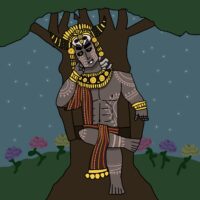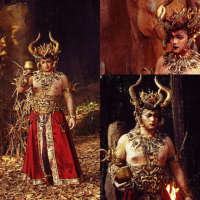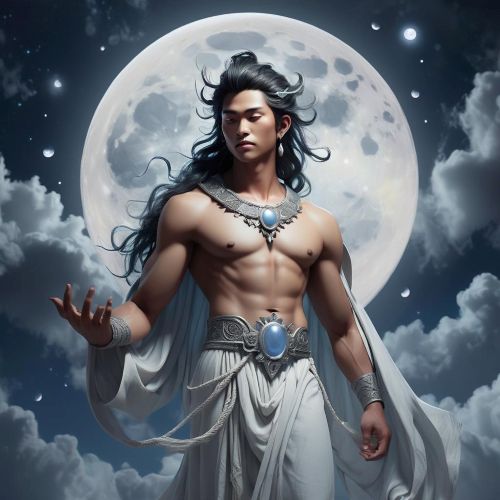Sidapa : God of Death
Listen
At a glance
| Description | |
|---|---|
| Origin | Philippine Mythology |
| Classification | Gods |
| Family Members | Libulan (Partner) |
| Region | Philippines |
| Associated With | Death, Lifespan |
Sidapa
Introduction
Sidapa is a revered figure in precolonial Philippine mythology, particularly among the Visayan and Bicolano peoples. Recognized as the god of death and fate, Sidapa plays a central role in the mythological understanding of mortality, destiny, and the transition between worlds. His domain is Mount Madjaas, a sacred and often mystical mountain where he is believed to oversee the lifespans of mortals. What sets Sidapa apart is not just his authority over death but the poetic balance he represents—between endings and beginnings, between the earthly and the celestial. This duality imbues his character with a complexity that continues to captivate modern interpretations of ancient Filipino beliefs.
Physical Traits
Sidapa’s appearance reflects his otherworldly power and his dominion over the unseen forces of life and death. He is portrayed as a tall, dark-skinned deity with a noble and commanding figure. The presence of a single horn rising from his head symbolizes divine strength and his unique status among gods. Legends often place him amidst the ethereal setting of Mount Madjaas, where moonlight, mist, and the hush of nature contribute to his mystique. In contemporary adaptations, artists and writers have enhanced his visual image to reflect a haunting beauty—elegant, ethereal, and almost regal. He is not a grotesque figure of fear but rather an awe-inspiring god who embodies both authority and gentleness, reflecting the nuanced role of death in life.
Family
Traditional narratives provide limited information about Sidapa’s familial connections. However, modern stories often center on his deep bond with Libulan (or Bulan), the moon god. Their relationship is depicted as one of romantic affection, in which Sidapa offers symbolic gifts like birds and fireflies to win Libulan’s heart. This tale of divine love between two male deities has gained significance in contemporary culture, especially within LGBTQ+ circles. Though this romantic narrative lacks firm grounding in early ethnographic accounts, it has become a powerful modern myth celebrating queerness and cosmic harmony. In contrast, some regional traditions have portrayed Sidapa with female attributes or identities, indicating a fluid interpretation across different communities and time periods.
Other names
The name Sidapa remains the most widely recognized, but scholars have explored possible connections to names from older Southeast Asian traditions. One such theory links Sidapa to “Sri Pada,” a term associated with sacred footprints, notably connected to the Hindu god Vishnu. This connection hints at the syncretic blend of indigenous and Hindu-Buddhist beliefs during the height of trade and cultural exchange in maritime Southeast Asia. However, there are no documented alternate names for Sidapa in the early Spanish-era texts or oral traditions, underscoring his distinct and enduring identity in the native pantheon. Despite this, the singularity of his name does not limit the depth or variety of stories in which he features.
Powers and Abilities
Sidapa’s most profound power lies in his control over life’s finite nature. According to legend, he marks the lifespan of every individual on a sacred tree atop Mount Madjaas. Each notch represents a life, and when the time designated is fulfilled, Sidapa summons the soul and escorts it to the afterlife. His scythe, mounted on a mystical chain, is a recurring symbol in his mythology—serving not just as a weapon but as a divine tool of transition. Sidapa’s supernatural capabilities extend to summoning spirits of the earth and sea, guiding them to protect or punish as necessary. He can move through shadows and vanish from view, a testament to his liminal role between life and death. In some accounts, he also influences natural elements like tides and moonlight, especially in stories involving Bakunawa, the sea serpent, and his celestial companion Libulan. These multifaceted powers position him not merely as a grim reaper but as a careful weaver of fate, emotion, and nature.
Modern Day Influence
Sidapa has found renewed popularity in the modern cultural and digital renaissance of Philippine mythology. Artists, writers, and creators have embraced his story, drawing upon its emotional depth and mystical symbolism. His romantic link with Libulan has been particularly impactful in the realm of LGBTQ+ storytelling, offering a mythological precedent for same-gender love in Filipino folklore. Though this romantic tale is more a product of modern imagination than historical documentation, it has sparked meaningful dialogue about inclusivity and identity within cultural narratives. Sidapa has appeared in various forms of pop culture, from television shows like Indio to digital art collections that visualize him as a brooding, noble figure. In online communities and graphic novels, he is often reinterpreted as a protector of love and justice, sometimes even portrayed as a superhero. These adaptations showcase not only his evolving image but also the cultural hunger to reconnect with native mythologies in ways that speak to current values and social movements. His resurgence also ties into efforts to decolonize historical perspectives and revive indigenous spirituality, cementing Sidapa’s relevance in both ancient belief and modern expression.
Related Images
Source
Jocano, F. L. (1968). Notes on Philippine Divinities. Retrieved from https://asj.upd.edu.ph/mediabox/archive/ASJ-06-02-1968/jocano-notes-philippine-divinities.pdf
Balladeer’s Blog. (2024). PHILIPPINE SUPERHEROES: SANDUGUAN. Retrieved from https://glitternight.com/2024/11/23/philippine-superheroes-sanduguan/
Acaballz. (2025). Sidapa, the God of Death and Fate. Retrieved from https://acaballz.com/blogs/blog/sidapa-the-god-of-death-and-fate
Medium. (2024). Sidapa at Libulan. Retrieved from https://medium.com/@creii/sidapa-at-libulan-98298da46495
OwlCation. (2025). A Controversial Love Affair of Two Male Deities in Filipino Myth. Retrieved from https://owlcation.com/curiosities/sidapa-x-bulan-a-love-story-between-two-male-gods-in-filipino-mythology
Making Queer History. (2018). Queer Mythology in the Philippines – Making Queer History. Retrieved from https://www.makingqueerhistory.com/articles/2018/12/19/queer-mythology-in-the-philippines
Scholarly Publishing Collective. (2023). My Gender is Precolonial: Transtemporal Minoritarian Aesthetics in “Diwata”. Retrieved from https://scholarlypublishingcollective.org/msup/qed/article/10/2/118/386737
Frequently Asked Questions
What is lorem Ipsum?
I am text block. Click edit button to change this text. Lorem ipsum dolor sit amet, consectetur adipiscing elit. Ut elit tellus, luctus nec ullamcorper mattis, pulvinar dapibus leo.
What is lorem Ipsum?
I am text block. Click edit button to change this text. Lorem ipsum dolor sit amet, consectetur adipiscing elit. Ut elit tellus, luctus nec ullamcorper mattis, pulvinar dapibus leo.
What is lorem Ipsum?
I am text block. Click edit button to change this text. Lorem ipsum dolor sit amet, consectetur adipiscing elit. Ut elit tellus, luctus nec ullamcorper mattis, pulvinar dapibus leo.
What is lorem Ipsum?
I am text block. Click edit button to change this text. Lorem ipsum dolor sit amet, consectetur adipiscing elit. Ut elit tellus, luctus nec ullamcorper mattis, pulvinar dapibus leo.
What is lorem Ipsum?
I am text block. Click edit button to change this text. Lorem ipsum dolor sit amet, consectetur adipiscing elit. Ut elit tellus, luctus nec ullamcorper mattis, pulvinar dapibus leo.












